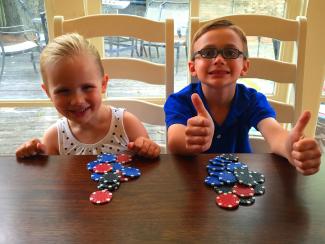
Financial Behavior Education For Children
Several times a year, a client or friend asks me how to teach good financial behavior to children. Sadly, there are not enough resources devoted to the topic. Our education system is designed to primarily teach us how to be productive in a job, not how to succeed in life. Most of us are left to witness our family’s behavior and decide if we want to emulate it or not. If we do not, it can be a tough road to maneuver without a map.
I have two young children: John Marshall, age 6, and Amelia, age 3. I’ve researched the topic of money management and children, and I’ve used that research along with some of my professional training to inform my parenting. With a father who is a financial advisor and a mother who is a clinical psychologist, our children will probably grow up to tell us that we spent an awful lot of time imparting behavioral lessons :-). Today I am going to share with you a behavioral game that we modified to serve as a foundation for our kids’ understanding of their personal finances.
It starts with a pack of poker chips (eventually I had to buy a second pack). We then sat down with the kids and created a list of activities we expect them to do and three family rules.
Example Activities:
- Help get yourself ready to go to school in the morning.
- Stay in bed and be quiet after you have been tucked in.
Our 3 Family Rules:
- Stay calm.
- Don’t touch anyone unless they give you permission.
- Do what your parents tell you to do the first time.
The activities are assigned a set value which determines the amount of the reward earned if the child does the activity completely with minimal complaint (e.g., getting ready for school earns 3 coins). They also earn and lose coins throughout the day based on our 3 family rules. We learned early on that it is best to be generous with giving coins and quick to take them away. Coins are gained and lost in the moment (i.e., with minimal lag time between the coin being earned or lost and the coin being actually given to or taken from the child). The coins have to go directly to and from our hands and theirs.
Our children keep their coins in their rooms and once they have accumulated 10 coins we treat them like a paycheck. One coin goes into a pile to give to those in need, 1 coin goes to saving for college, and 8 coins can be used for them to enjoy. John Marshall likes to save his coins and use them on big excursions like a trip up to the top of Vulcan or an afternoon at Chuck-E-Cheese. Amelia likes to spend one coin at a time. Her most frequent purchase, a baggie containing 10 chocolate chips, retails for 1 coin in our house.
As I am sure you have already deduced, the game serves 2 purposes:
- When done consistently, it is a good obedience tool.
- The kids are learning prudent financial behavior.
If you have any activities or lessons that have worked for you I would love to hear about them.
-Marshall Rathmell-

